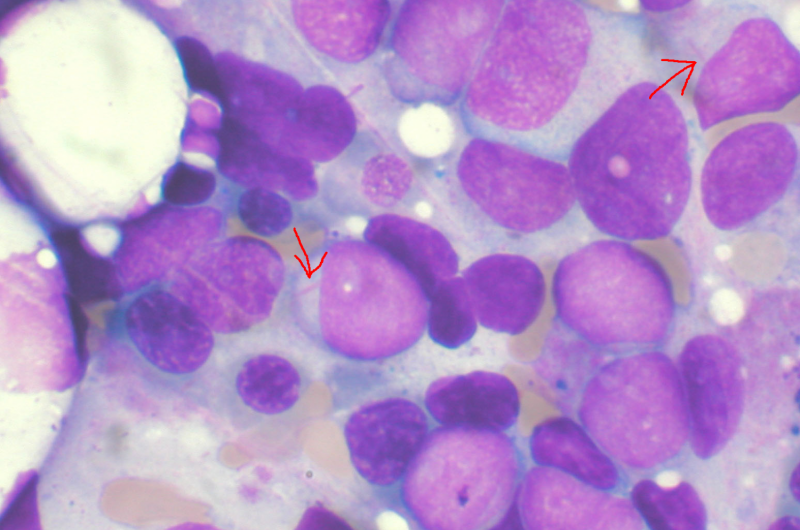Bone marrow aspirate showing acute myeloid leukemia. Several blasts have Auer rods. Credit: Wikipedia
Scientists from the Wellcome Sanger Institute and the University of Cambridge found that in children with neuroblastoma—a cancer of immature nerve cells—treatment with platinum chemotherapy caused changes to the genome that could then cause leukemia in some children later on.
The findings, published 27th May 2021 in Blood could lead to an ability to identify which children are more likely to develop the secondary cancer. This in turn could lead to changes in their treatment plan to either avoid these risks or take measures to prepare.
Secondary blood cancer is a challenging complication of childhood neuroblastoma cancer treatment. Every year around 100 children in the UK are diagnosed with neuroblastoma*, and those who had high-risk treatment are at an increased risk of developing secondary blood cancer—leukemia—after neuroblastoma treatment.
Neuroblastoma often requires intense treatment including several chemotherapy drugs. These powerful drugs kill cancer cells very effectively but unfortunately also have side effects, including damaging the DNA of healthy cells, including bone marrow cells. In up to 7 per cent of childhood neuroblastoma survivors, damaged bone marrow cells go on to develop into secondary leukemia.
In this new study, researchers from the Wellcome Sanger Institute and the University of Cambridge sequenced the whole genomes of bone marrow and blood samples of two children who both had developed blood cancer following high-risk neuroblastoma treatment. They discovered that the seeds of secondary leukemia were sown by neuroblastoma chemotherapy right at the beginning of treatment.
Dr. Sam Behjati, co-lead author and group leader at the Wellcome Sanger Institute, said: "We have been able to unravel the root of secondary leukemia in these children which seems to lie in the early stages of neuroblastoma treatment. We hope to further investigate this to try to identify children at higher risk, and to inform a more tailored treatment plan to reduce the risk of secondary leukemia."
The team found that in both patients the leukemia had mutations that were caused by neuroblastoma chemotherapy. A wider analysis of 17 children treated for a variety of cancers then identified another child who had undergone neuroblastoma treatment and had developed pre-leukemia seeds. In the future, it could be possible to identify the children who have a higher risk of developing secondary leukemia by sequencing their genome and highlighting any genetic drivers that could be pre-cursors for blood cancer.
Dr. Grace Collord, joint first author from the Wellcome Sanger Institute, said: "This research would not have been possible without the contributions of the patients and their families, and we are indebted to them for their participation in this study. Understanding the reason why some childhood cancer survivors go on to develop secondary blood cancer is crucial if we are to find a way to help protect against this devastating complication."
Professor John Anderson of Great Ormond Street Hospital, who contributed to this study, said: "Neuroblastoma can be an aggressive disease that requires intense chemotherapy treatment. Occasionally this chemotherapy can cause serious adverse effects such as leukemia. So these findings are important to inform possible strategies for monitoring for secondary cancer and tailoring individual treatment plans. However, I should stress that it remains vital that children with high risk neuroblastoma continue to receive intense treatment for their cancer."
More information: Tim H. H. Coorens et al, Clonal hematopoiesis and therapy-related myeloid neoplasms following neuroblastoma treatment, Blood (2021). DOI: 10.1182/blood.2020010150
Journal information: Blood
Provided by Wellcome Trust Sanger Institute
























